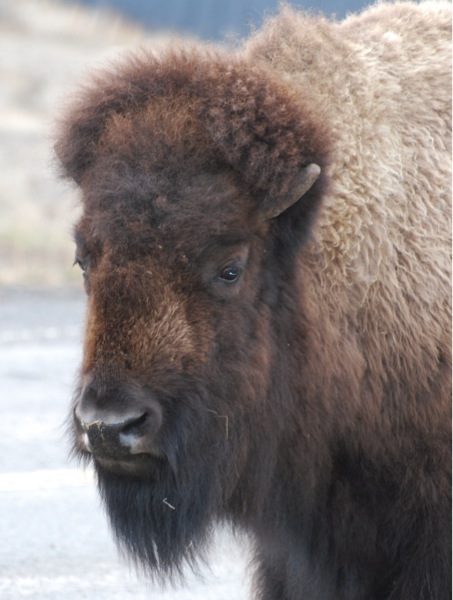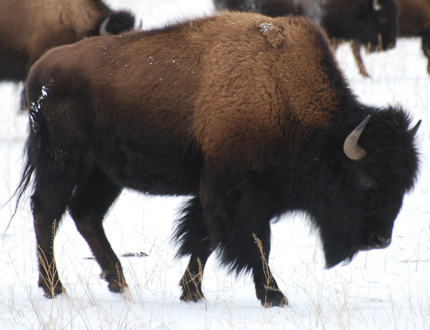
I never tire of gazing at bison in Yellowstone. I find them magnificent creatures and they are inextricably linked for me to a prehistoric time when 60 million of their ancestors roamed in endless herds across North America (one explorer noted a sea of buffalo that stretched 20 miles wide).
In the winter I salute their tenacious survival skills, and smile when I see a bison "snow angel," the marks in the snow left from them brushing their head from side-to-side in search of sparse forage underneath. Somehow these 2,000 pound animals scratch out a living in Yellowstone's extreme winter by eating mostly dead plants--what we would consider the equivalent of munching on cardboard.
May is my favorite time in Yellowstone, as bison give birth to what some visitors mistake for "little orange dogs." Although an adult bison can't really be described as cute, a bison calf is pretty darn adorable. Last year a bison calf was born in my front yard and another in the snow right outside my office. When my parents visited Yellowstone, they witnessed a grizzly bear take down a bison calf at Old Faithful-- and saw members of the herd brave the danger and go back to try and unsuccessfully retrieve the calf.
 And if one needs a further testament to the intrepid spirit of this remarkable animal, we need only recall the story (and look again at the photos) that went viral last year of a bison, badly burned from a fall in a hot spring, who still managed to outrun a hungry grizzly bear.
And if one needs a further testament to the intrepid spirit of this remarkable animal, we need only recall the story (and look again at the photos) that went viral last year of a bison, badly burned from a fall in a hot spring, who still managed to outrun a hungry grizzly bear.
On this blog, for the most part, I prefer to steer away from opinion and instead inspire others by simply sharing the wonders of Yellowstone. Yet when I read this evening that one of the test bison I had written about in my prior post was killed as a result of it not staying within the prescribed safe area, a profound sadness overcame me.
Last week marked the beginning of what many heralded as a new era of bison tolerance on the northern range of Yellowstone when a test group of bison were released and allowed to roam outside the park boundary for the first time in decades. Yet not even a week later one of the herd is slaughtered for refusing to move from private property adjacent to the newly designated protection corridor.
 This has been a very snowy winter and even the lower elevations of the park near Gardiner have received above average snow. The bison was probably hungry and tired and had no conception that his quest for greener pastures would result in death. The punishment doesn't seem to fit the crime. Bison with ancestors who once roamed the entire continent don't perceive property lines, they see the world in terms of survival and migrate where they find a food source. So why was this bison shot? Allegedly to prevent the spread of brucellosis to livestock, although most sources I have consulted say there has never been a documented case of a bison spreading the disease to cattle.
This has been a very snowy winter and even the lower elevations of the park near Gardiner have received above average snow. The bison was probably hungry and tired and had no conception that his quest for greener pastures would result in death. The punishment doesn't seem to fit the crime. Bison with ancestors who once roamed the entire continent don't perceive property lines, they see the world in terms of survival and migrate where they find a food source. So why was this bison shot? Allegedly to prevent the spread of brucellosis to livestock, although most sources I have consulted say there has never been a documented case of a bison spreading the disease to cattle.
The Yellowstone bison are part our our national heritage, they are the last continuous descendants of the mighty wild herds of bison that once wandered our country. In the early 1900s, bison had dwindled from the 60 million animals that existed prior to the mid 1800s to less than two dozen hiding out in Yellowstone. In one of the most significant conservation measures of our time, the park restored the herd back to health, and today over 3,000 bison call Yellowstone their home.
When confronted with the historical mass slaughter of the great bison herds, most of us express dismay. And although it was only a single bison shot this weekend, I feel the same sadness. Have we still not learned to cherish wildness and the specialness of wild creatures? If even one bison can't find protection in the last sanctuary for his kind, then we as a people may need to rethink our priorities.
